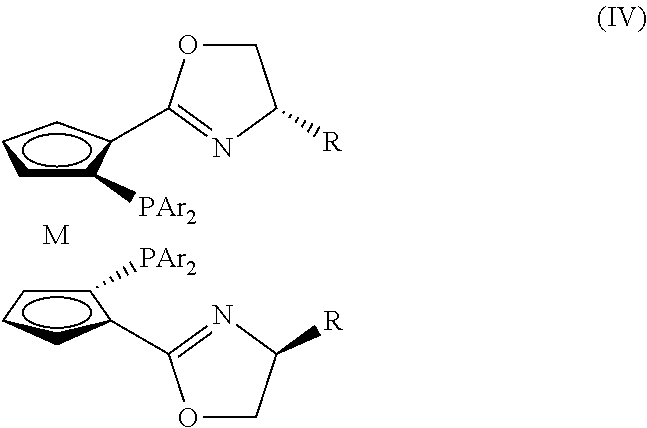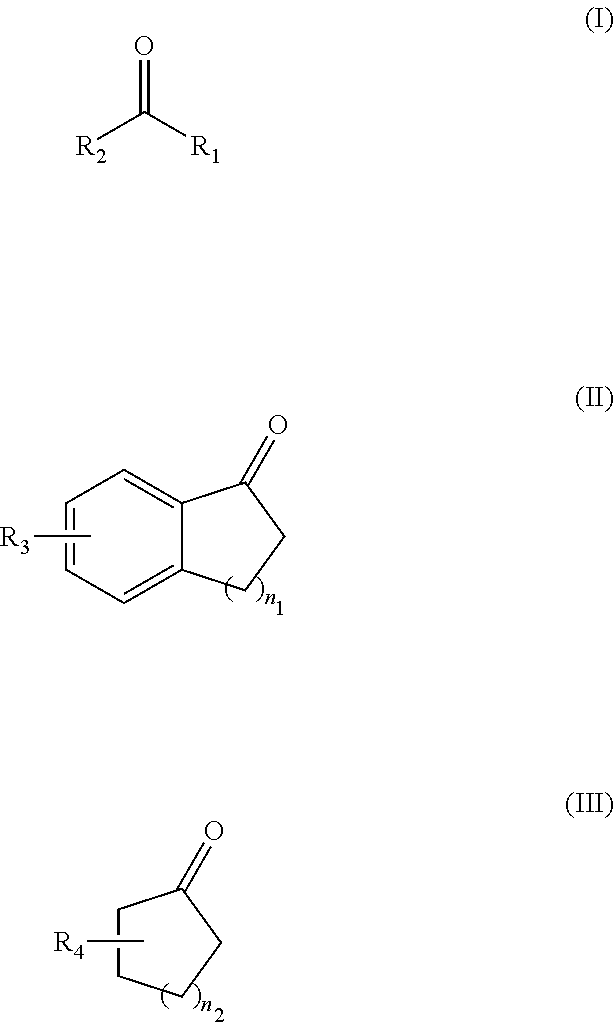Asymmetric hydrogenation method for ketone compound
a hydrogenation method and ketone compound technology, applied in the field of organic chemistry and drug synthesis chemistry, can solve the problems of difficult to synthesize such ligands, inability to stably store ligands, and high cost, and achieve convenient and effective synthesis of enantiomerically pure alcohols, high yield, and simple synthesis
- Summary
- Abstract
- Description
- Claims
- Application Information
AI Technical Summary
Benefits of technology
Problems solved by technology
Method used
Image
Examples
example 1
Preparation of 1-phenethanol from acetophenone
[0052]
[0053]Tris(triphenylphosphine)ruthenium(II) chloride (3.8 mg, 4 μmol, 1 mol %) and a chiral ligand (M=Ru, R=i-Pr, Ar=4-MeC6H4—, 2.6 μmol, 0.65 mol %) were dissolved in methanol (3 mL) under nitrogen atmosphere, and then heated and stirred for 2 h at 65° C. After the mixture was cooled to room temperature, acetophenone (0.4 mmol), methane (2 mL), and a solution of sodium hydroxide in methane (0.4 mL, 0.2 M) were added thereto. The reaction system was placed in an autoclave, and stirred for 12 h under H2 (10 atm) at 10° C. The solvent was removed under reduced pressure, and the resultants were separated by column chromatography (silica gel column; eluent: ethyl acetate / petroleum ether=1 / 5). Accordingly, pure 1-phenethanol was obtained and the ee value (ee=97%) was measured by GC analysis.
example 2
Preparation of 1-phenethanol from acetophenone
[0054]
[0055]Tris(triphenylphosphine)ruthenium(II) chloride (3.8 mg, 4 μmol, 1 mol %) and a chiral ligand (M=Ru, R=s-Bu, Ar=C6H5—, 2.6 μmol, 0.65 mol %) were dissolved in ethanol (3 mL) under nitrogen atmosphere, and then heated and stirred for 2 h at 80° C. After the mixture was cooled to room temperature, acetophenone (0.4 mmol), ethanol (2 mL), and a solution of sodium hydroxide in ethane (0.4 mL, 0.2 M) were added thereto. The reaction system was placed in an autoclave, and stirred for 12 h under H2 (20 atm) at 10° C. The solvent was removed under reduced pressure, and the resultants were separated by column chromatography (silica gel column; eluent: ethyl acetate / petroleum ether=1 / 5). Accordingly, pure 1-phenethanol was obtained and the ee value (ee=99.0%) was measured by GC analysis.
example 3
Preparation of 1-phenethanol from acetophenone
[0056]
[0057]Tris(triphenylphosphine)ruthenium(II) chloride (3.8 mg, 4 μmol, 1 mol %) and a chiral ligand (M=Fe, R=Me, Ar=3,5-(CF3)2C6H3—, 2.6 μmol, 0.65 mol %) were dissolved in toluene (3 mL) under nitrogen atmosphere, and then heated and stirred for 2 h at 120° C. After the mixture was cooled to room temperature, acetophenone (0.4 mmol), toluene (2 mL), and an aqueous solution of potassium hydroxide (0.4 mL, 0.2 M) were added thereto. The reaction system was placed in an autoclave, and stirred for 12 h under H2 (20 atm) at 10° C. The solvent was removed under reduced pressure, and the resultants were separated by column chromatography (silica gel column; eluent:ethyl acetate / petroleum ether=1 / 5). Accordingly, pure 1-phenethanol was obtained and the ee value (ee=99.3%) was measured by GC analysis.
PUM
| Property | Measurement | Unit |
|---|---|---|
| hydrogen pressure | aaaaa | aaaaa |
| temperature | aaaaa | aaaaa |
| temperature | aaaaa | aaaaa |
Abstract
Description
Claims
Application Information
 Login to View More
Login to View More - R&D
- Intellectual Property
- Life Sciences
- Materials
- Tech Scout
- Unparalleled Data Quality
- Higher Quality Content
- 60% Fewer Hallucinations
Browse by: Latest US Patents, China's latest patents, Technical Efficacy Thesaurus, Application Domain, Technology Topic, Popular Technical Reports.
© 2025 PatSnap. All rights reserved.Legal|Privacy policy|Modern Slavery Act Transparency Statement|Sitemap|About US| Contact US: help@patsnap.com



